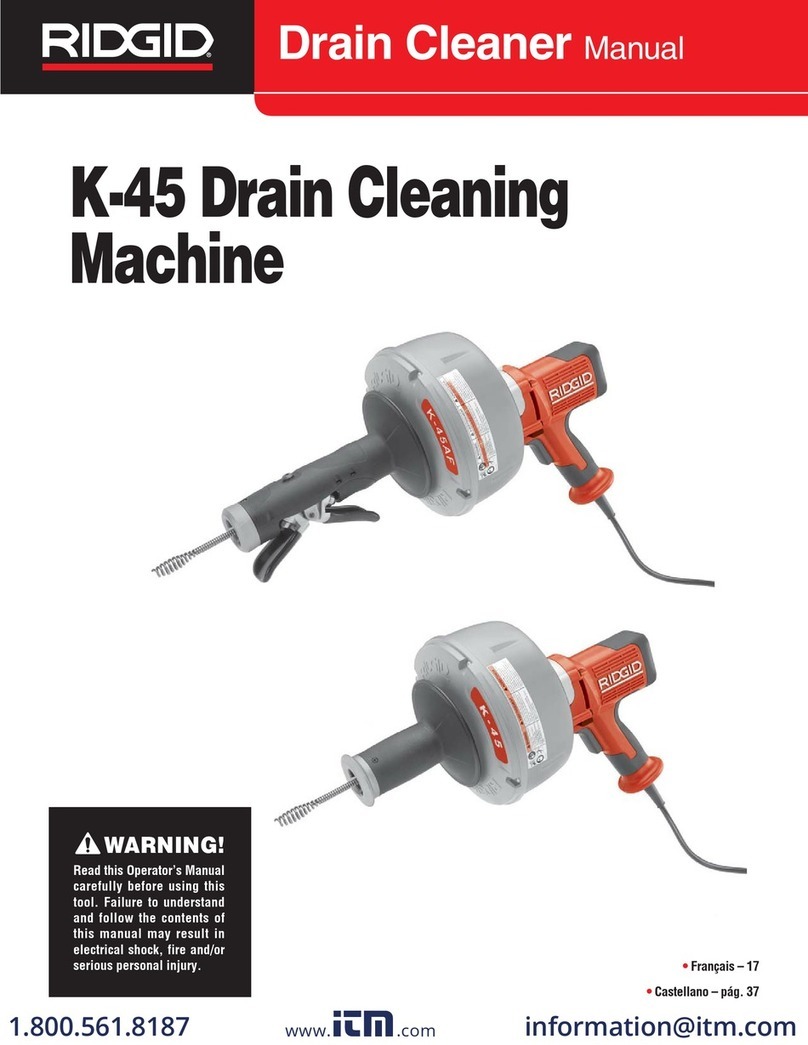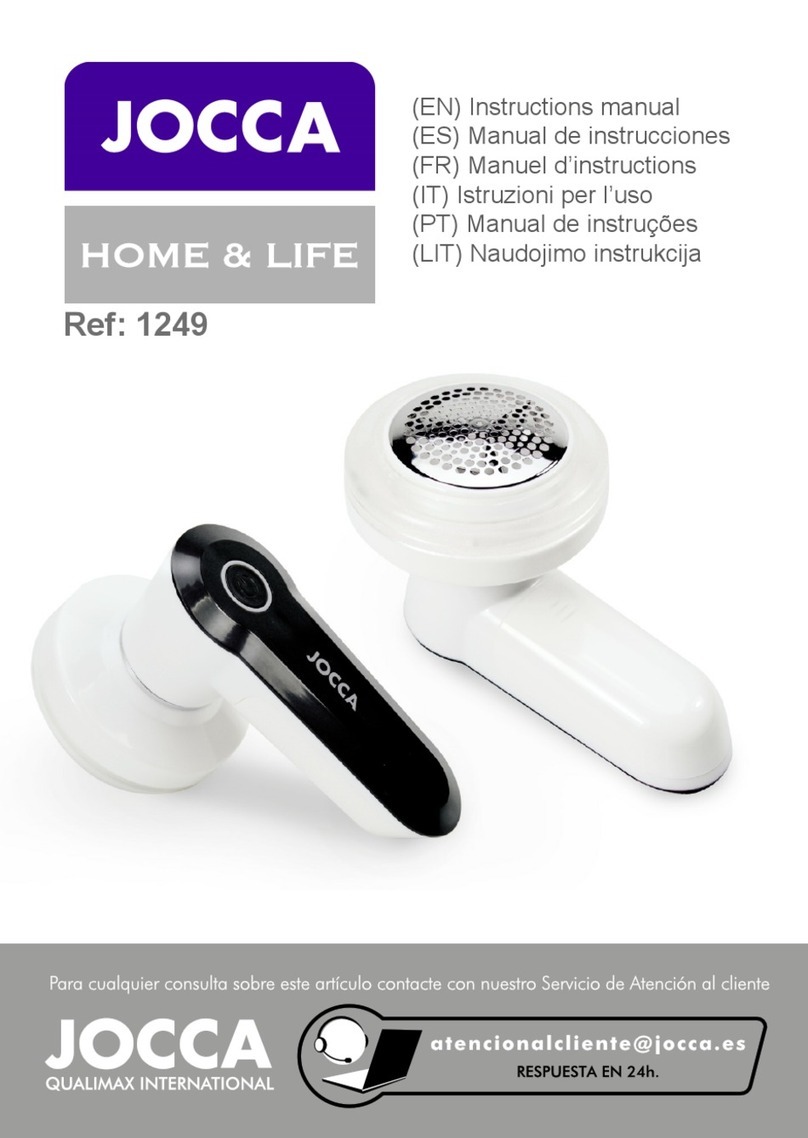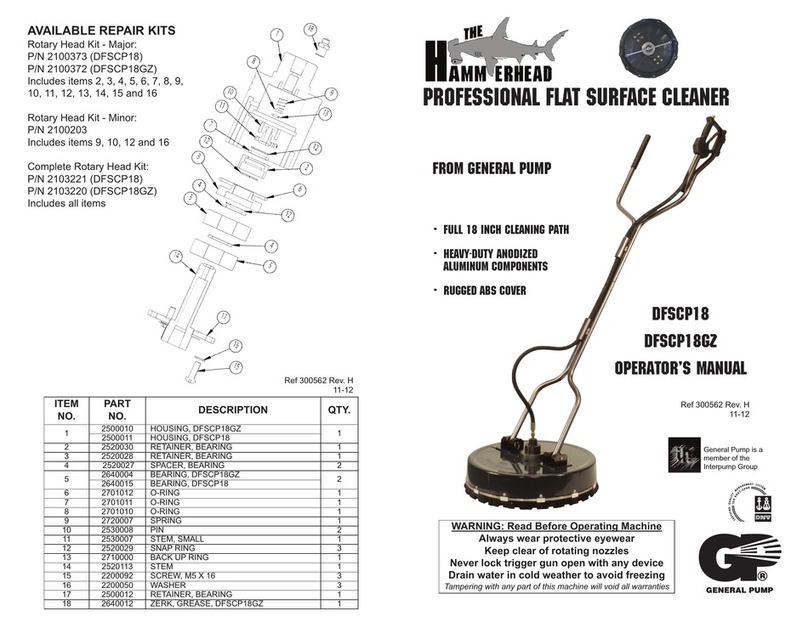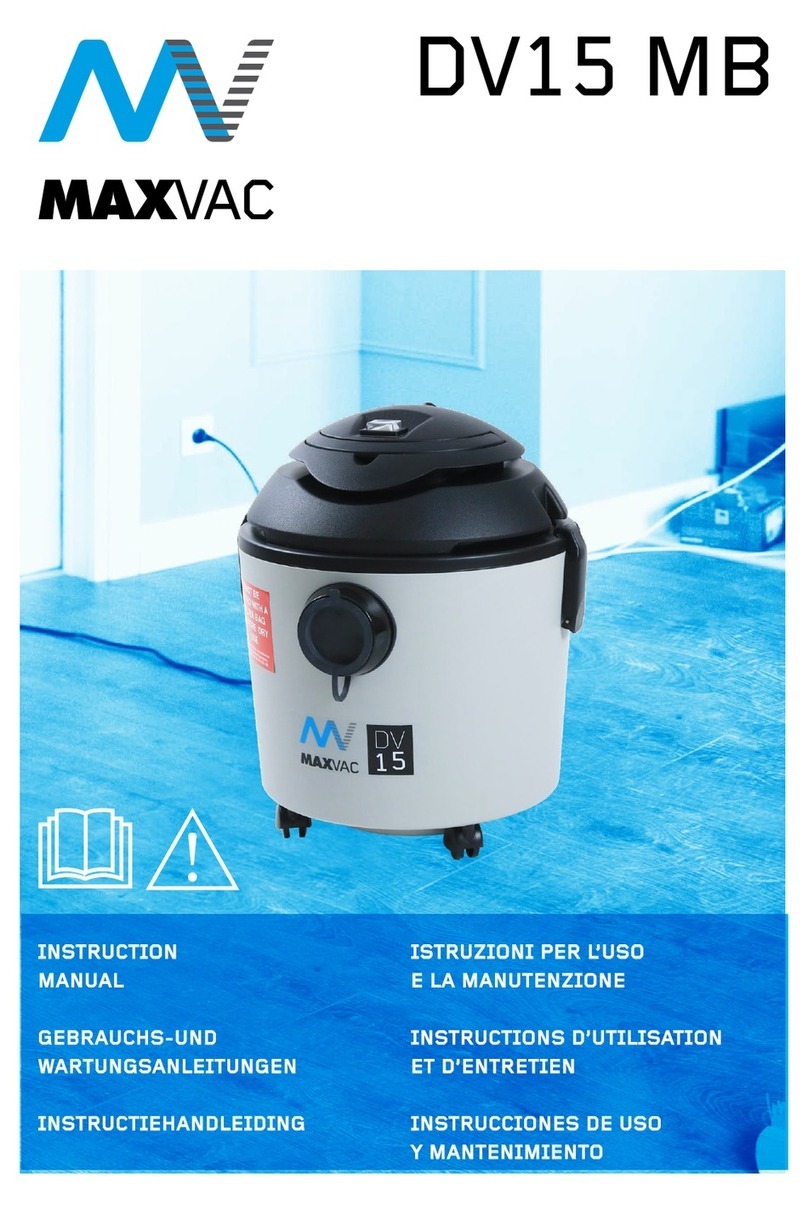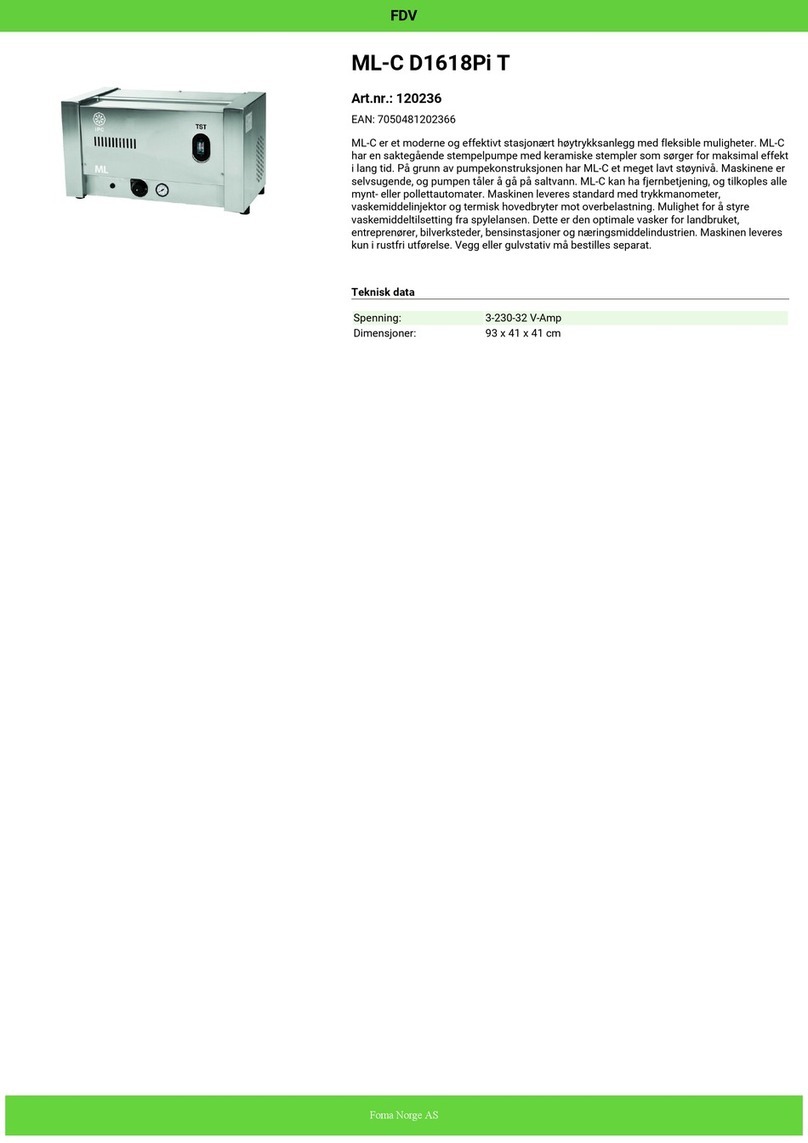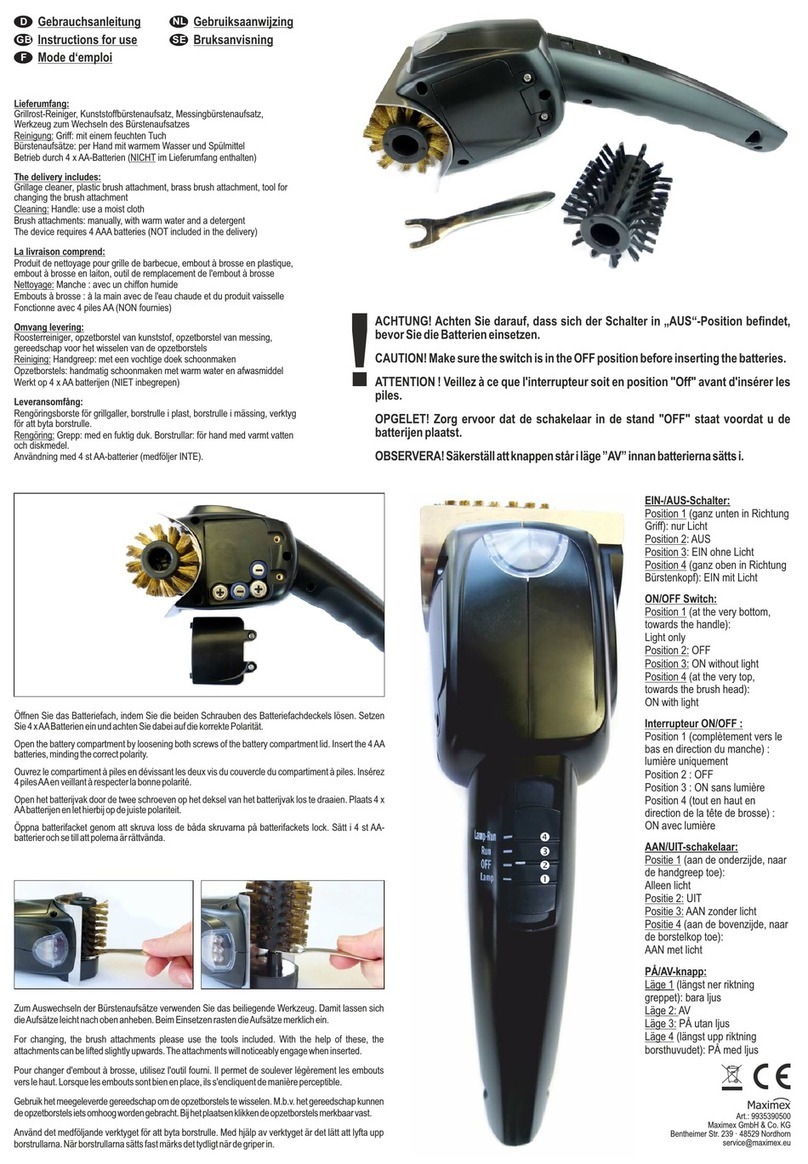TMG TMG-APW20 User manual

20 GALLON PARTS WASHER
PRODUCT MANUAL
v2023.08.26
TMG-APW20
Please read and understand the product manual completely before assembly
Check against the parts list to make sure all parts are received
Wear proper safety goggles or other protective gears while in assembly
Do not return the product to dealer. They are not equipped to handle your requests.
Missing parts or questions on assembly?
Please call: 1-877-761-2819 or email: cs@tmgindustrial.com

TABLE OF CONTENTS .....................................................................................................................2
SAFETY INFORMATION...........................................................................................................................3
SPECIFICATION.................................................................................................................................................6
COMPONENTS AND CONTROLS....................................................................................................................6
UNPACKING & ASSEMBLY..............................................................................................................................7
OPERATION...................................................................................................................................................8
CARE & MAINTENANCE..............................................................................................................10
TROUBLESHOOTING..................................................................................................................................10
PARTS DIAGRAM..........................................................................................................................................11
TABLE OF CONTENTS

Before operating the PARTS WASHER read the following safety instructions. Failure to comply with
these warnings may result in serious injury or death.
SAFETY INSTRUCTIONS
The alert symbol is used throughout this manual and this manual and on the product safety decals. This symbol indicates
attention is required and identifies hazards concerning your personal safety and the safety of others. Please follow the
recommended precautions
The safety alert symbol means...
ATTENTION! BECOME ALERT! YOUR SAFETY IS INVOLVED!
NOTICE -This notice indicates that a specific hazard or unsafe practice will result in equipment or property damage, but not
personal injury.
IMPORTANT SAFETY INFORMATION
WARNING
This notice indicates a specific hazard or unsafe practice that could result in severe personal injury or death if the
proper precautions are not taken.
CAUTION
This notice indicates a potentially hazardous situation that may result in minor or moderate injury if proper
practices are not taken.
DANGER
This notice indicates an immediate and specific hazard that will result in severe personal injury or death if the
proper precautions are not taken.

INTRODUCTION
The 20 Gallon Parts Washer is ideal for cleaning grimy parts with water- based solvents. It has a steel flex nozzle and lid with an
electrical safety link in the hinge.
SAFETY
WARNING!
Read and understand all instructions before using this tool. The operator must follow basic precautions to reduce the risk of
personal injury and/or damage to the equipment.
Keep this manual for safety warnings, precautions, operating or inspection and maintenance instructions.
WORK AREA
1. Operate in a safe work environment. Keep your work area clean, well- lit and free of distractions. Place lights so you are not
working in a shadow.
2. Keep anyone not wearing the appropriate safety equipment away from the work area.
3. Store unused tools properly in a safe and dry location to prevent rust or damage. Lock tools away and keep out of the reach
of children.
4. Do not install or use in the presence of flammable gases, dust or liquids.
5. Do not use near heat or spark sources such as heaters, open flames or tools that produce sparks.
PERSONAL SAFETY
WARNING!
Wear personal protective equipment approved by the Canadian Standards Association (CSA) or American National Standards
Institute (ANSI).
Personal protective equipment
1. Always wear impact safety goggles that provide front and side protection for the eyes. Eye protection equipment should
comply with CSA Z94.3-07 or ANSI Z87.1 standards based on the type of work performed.
2. Wear the appropriate type of full-face shield in addition to safety googles, as the work can create molten, acid or chemical
splashes.
3. Wear gloves that provide protection based on the work materials or to reduce the effects of tool vibration.
4. Wear protective clothing designed for the work environment and tool.
5. Non-skid footwear is recommended to maintain footing and balance in the work environment.
Personal precautions
Control the tool, personal movement and the work environment to avoid personal injury or damage to tool.
1. Do not operate any tool when tired or under the influence of drugs, alcohol or medications.
2. Avoid wearing clothes or jewelry that can become entangled with the moving parts of a tool. Keep long hair covered or bound.
3. Do not overreach when operating a tool. Proper footing and balance enables better control in unexpected situations.
SPECIFIC SAFETY PRECAUTIONS
WARNING!
DO NOT let comfort or familiarity with product (gained from repeated use) replace strict adherence to the tool safety rules. If you
use this tool unsafely or incorrectly, you can suffer serious personal injury.
1. Use the correct tool for the job. This tool was designed for a specific function. Do not modify or alter this tool or use it for an
unintended purpose.
2. Do not use the tool if any parts are damage broken or misplaced. Repair or replace the parts.
3. Only use water-based solvents with the parts washer.

4. Do not modify the washer lid or the lid arm to keep the lid open. Heat from a fire will melt the fusible link and the washer lid
will automatically fall to smother the flames.
5. Use the parts washer in a well-ventilated area to avoid fume build up from the solvent.
ELECTRICAL SAFETY
WARNING!
To reduce risk of electric shock, be certain that the plug is connected to a properly grounded receptacle.
1. Disconnect the tool from the power supply before making any adjustments, changing accessories, cleaning, servicing or
when storing. Such preventive safety measures reduce the risk of starting the tool accidentally
2. Protect yourself against electric shocks when working on electrical equipment. Avoid body contact with grounded surfaces.
There is an increased chance of electrical shock if your body is grounded.
3. Do not disconnect the power cord in place of using the power switch. This will prevent an accidental start-up when the power
cord is plugged into the power supply.
a. In the event of a power failure, turn off the machine as soon as the power is interrupted. The possibility of accidental
injury could occur if the power returns and the unit is not switched off.
4. Do not alter any parts of the tool or accessories. All parts and accessories are designed with built-in safety features that may
be compromised if altered.
5. Make certain the power source conforms to requirements of your equipment (see Specifications).
6. This tool is only for use on 120 V (single phase) and is equipped with a three-prong grounded power supply cord and plug.
Check with a qualified electrician if you are in doubt as to whether the outlet is properly grounded. If the tool should
electronically malfunction or break down, grounding provides a low resistance path to carry electricity away from the user.
a. Never remove the grounding prong or modify the plug in any way, as this will render the tool unsafe.
b. Do not use any adapter plugs.
WARNING! All wiring should be performed by a qualified electrician.
POWER CORD
1. Insert the power cord plug directly to the power supply whenever possible. Use extension cords or surge protectors only
when the tools power cord cannot reach a power supply from the work area.
a. When operating a tool outside, use an outdoor extension cord marked W-A or W. These cords are rated for outdoor use
and reduce the risk of electric shock.
b. Use in conjunction with a Ground Fault Circuit Interrupter (GFCI). It is recommended that the GFCI should have a rated
residual current of 30 mA or less.
2. Do not operate this tool if the power cord is frayed, damaged or poorly spliced, as an electric shock may occur, resulting in
personal injury or property damage.
a. Inspect the tools power co rd for cracks, fraying or other faults in the insulation or plug before each use.
b. Discontinue use if a power cord feels more than comfortably warm while operating the tool.
3. Keep all connections dry and off the ground to reduce the risk of electric shock. Do not touch the plug with wet hands.
4. Prevent damage to the power cord by observing the following:
a. Do not pull on the cord to disconnect the plug from an outlet.
b. Keep the cord away from heat, oil, sharp edges or moving parts.
c. Never use the cord to carry the tool.
d. Place the electrical cord in a position that prevents it from coming into contact with the tool and getting caught by the
workpiece. The cord should always stay behind the tool.
5. Do not allow people, mobile equipment or vehicles to pass over unprotected power cords.
a. Position power cords away from traffic areas.
b. Place cords in reinforced conduits or place planks on either side of the power cord to create a protective trench.
6. Do not wrap the cord around the tool, as sharp edges may cut insulation or cause cracks if wound too tight. Gently coil cord
and either hang on a hook or fasten with a device to keep cord together during storage.
Table of contents


